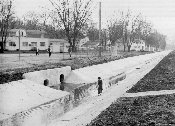

MSD Photos by Martin E. Biemer
On Saturday, August 8, 1992, heavy rainstorms dumped nearly six inches of rain in three hours on parts of Louisville. The old combined sanitary and storm sewer system was overwhelmed.
Water flooded basements, gushed up through manholes, flooded streets and yards, and even flooded the first floors of houses in one southern Louisville neighborhood. Thirty of the buildings at the University of Louisville were surrounded by water. A woman drowned when her car stalled in the rapidly rising water in a railroad underpass at Floyd and Hill Streets; other underpasses were flooded, as well.



MSD Photos by Martin E. Biemer
While rainstorms had caused similar problems many times in the past, few had created problems quite as severe over such a widespread area. It was a storm that would prompt significant changes in the way MSD handled local flooding problems.
Two of the changes involved a neighborhood just south of the Watterson Expressway and west of Taylor Boulevard, near the old Hazelwood Hospital grounds. The combined sewer system was dramatically overloaded; stormwater mixed with wastewater flooded the streets and entered the first-floor living areas of 18 homes.
After studying engineering reports, the MSD Board voted the following year to offer to floodproof these homes at MSD’s expense. The voluntary program could take one of several forms: raising the houses on their foundations to bring their first floors above flood level; making other modifications to keep water from entering the houses, or buying the houses and demolishing them. In the summer of 1994, the Board voted to make floodproofing one of the options MSD would consider in any appropriate drainage improvement plan.
The second change was the approval of the construction of a large floodwater detention basin north of Hazelwood Hospital. The basin would store the excess water entering the sewers during heavy storms, then release it slowly into the main sewer line when the danger of flooding had passed. While major detention basins had been required in new developments in the past, and had been planned and built along streams in relatively undeveloped areas, this was the first to be built in an older neighborhood at MSD’s expense.
The third change applied to many areas where sewers often backed up into basements during wet weather. Under previous MSD policy, property owners had been responsible for preventing water from backing up thorough the sewers into their basements. Under the new program, which would be offered at first in neighborhoods with the most frequent basement backups, MSD would pay for the installation of backup prevention devices.
"There was some controversy (about the programs)," said former chairperson Sandra Metts, "but the Board took the actions to address continuing problems. As Board members, we felt we represented the rate payers. They are our customers."
MSD History continued - The Floodplain Ordinance


